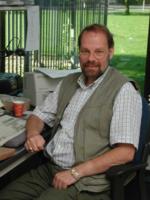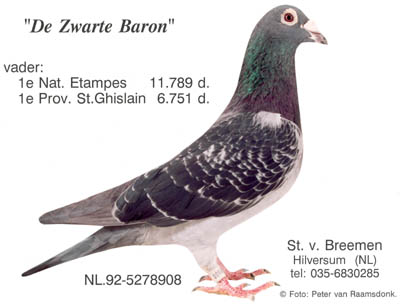Part 16
Summary of the selection

The selection is the most important means we have to improve the quality of our population from generation to generation. From year to year, we can realize better results by means of a focused, consequent selection. The evaluation is based in the first place on the results in the basket with racing pigeons, but there are numerous possibilities with which we can detect the performance of our pigeons on the basis of appearance and conduct. As I explained earlier the current standard qualifications are no help to rely on as far as the selection of pigeons is concerned. This standard clearly favors slow pigeons. The focus must be on champion pigeons, the fastest type if one wishes to breed real good competition pigeons.

"De Zwarte Baron" was bred out of "De Schonen"(son of "Het Boerke") and a pure Houben hen. His full brother "Black Magic" won 2nd and 4th in a National Dayrace and his halfbrother has bred the top 4 of the National Hannover race in Denmark. "De Zwarte Baron" produced a National & a Provincial winner. His daughter "Gisele" produced birds to win 2nd, 4th, 5th, 6th, 9th either in National races or in National Ace competitions. His daughter produced for Mr. Willem de Bruijn of Reeuwijk 2nd Nat. Ace Young 1998.
There are a few exterior characteristics which are common with each class pigeon. These are in the first place, the from-the-face projected enormous tenacity, the intelligence, the most of the time penetrating look, the elastic muscles, an extraordinary vitality and physical power which occasionally has something to do with a big body. Almost all class pigeons have without exception eyes with small pupils; in the light one can see that the total surface of the iris is richly pigmented and full of color. One sees these characteristics with most of the excellent racers. Regarding other exterior details, they are as different from each other as for example athletes in the Olympics.
When our pigeons have been correctly prepared, the best tool for selection is and remains the basket of course. Nevertheless, thorough observation of your pigeons based on specific abilities plays a serious part in the selection. When we would want to improve all of this by means of breeding, a well known proverb would apply: "He who wants the bottom out of the can, will get the lid on his nose". We must realize that there is a certain correlation between the different properties which according to their nature play their role in an improving or restraining manner. Such correlation's are:
Vitality: when vitality increases, the metabolism of the organism impro-ves automatically; it is easier to get into form; staying in form is of longer duration and the recuperation capacity is better.
Mordant: mordant goes always together with small pupils on account of the nerve system.
The above are therefore the positive correlation's.
Feathers: a too rich plumed pigeon is a property which is usually inherited together with sluggishness.
Wing: a shovel wing stands for sluggishness.
Bone structure: a too thick bone structure is also sluggish.
These are the negative correlation's.
One may not lose sight of the correlation's during the breeding season while many more can be added. Earlier I have written about the heredity forms of the different properties. Thus we can divide the for us interesting properties in two groups: those which are additive and those which are non additive.
To improve the quality of these characteristics one needs to continuously search for extra pigeons on other lofts who are better than our own as far as it is concerned such as character, intelligence, etc. This enables us to improve the characteristics mentioned with our pigeons.
That this is not easy can be illustrated by the fact that for more than 25 years I have been busy on my own loft to improve the muscle quality because I find it especially important. Yet, the quality of my pigeon's breast muscles is not as good as I would like, but better than with other fanciers who do not attach the same value to this property. The passed-on, non additive characteristics, can be grouped around vitality. They do not directly belong to surely passed-on character traits according to my investigations. This may perhaps sound like a paradox. Here again the already cited proverb applies when we want to improve of both groups at the same time with our technical breeding work. That's why we must keep the number of properties we consider important to a minimum so that improvement becomes noticeable. A lot of experience and know-how is needed to select, such very important properties.
Personally I consider the following characteristics as my most important final goal:
1. Mordant and the ability to fly a specific distance;
2. Intelligence;
3. Speed;
4. Muscle quality.
Of course I also strive to improve vitality and associated characteristics. I try to improve the above mentioned main characteristics by mating the best with the best. However I don't try to improve the characteristics which are grouped around vitality by means of selection, but rather by planned crossings. Thus the principle is: the characteristics which are passed-on in an additive manner are best improved by continuous selection and if necessary by crossing with another strain with excellent qualities. The breeding system is here: to mate the best with the best. The non additive characteristics are being brought at the desired level by correctly applied crossings. It is a prevalent opinion in zoology that regularly executed selection on the basis of certain additive characteristics leads to the shrinking of the variation scope. The shrinking of genetic variation leads to a reduction of the selection effect. The closer we come to the ceiling, the less progress will be noticed. No doubt this principle will be correct, but this ceiling is always still rather far away, reason why we can always continue with improving.
In this connection I would like to refer to the extraordinary, overdeveloped muscles of the Pietrain, the pig of the Belgian countryside. But this theme doesn't directly spell danger of our fanciers because we will not reach the ceiling so quickly in this regard(muscles, intelligence, speed, mordant). For as long as only 1-2% of our pigeons possess these so important characteristics to perfection we have nothing to fear.
There are often differences of opinion in zoology as to what is really more valuable: an excellent chance product out of a weak family, or an average specimen coming out of a famous family? It is generally said that it is better to select an average member out of a good family for further breeding than a sudden, seemingly excellent member from a lesser family. I feel that all important properties must be looked at from this point of view regardless whether they are passed-on in an additive, or in a non additive manner. That is the determining factor! When I would be placed before such a difficult choice I would answer as follows:
"When I would select an animal to buy for breeding purposes who is very valuable to his additive characteristics, I would definitely choose this extremely good animal, irrespective out of what family it comes. However, when I would focus on the non additive characteristics, I would when it concerns pedigree breeding for example- rather select an average member of a good family. When I purchase a pigeon, she must be in the first place excel in her additive characteristics. When I think about crossing, I must then again, apart from the family, select material that shows the best combination suitable for crossing. And this doesn't depend on the quality of the family, but rather on the combi-nation suitability in the crossing of the family. Therefore, there are three variants in three different situations".
It must be clear from the chapter that good management and especially overview is necessary for the selection. It is a task always demanding full attention when we wish to accomplish something big and durable. That is why I am convinced that fanciers striving for big success will read with great attention the many thoughts in this chapter!
Steven van Breemen
Copyright 1998. All rights reserved. Reproduction in whole, in part, in any form or medium, without the express written permission of Steven van Breemen, is forbidden.
The whole book can be downloaded from "Winning Magazine" if you are a subscriber. You can subscribe here; costs 35 Euro for 1 year. You get 26 issues and have access to the archives with all previous published issues plus next to "The Art of Breeding" a second book written by me: "Hints for Mating, Breeding & Selection". A total bargain!
| 
